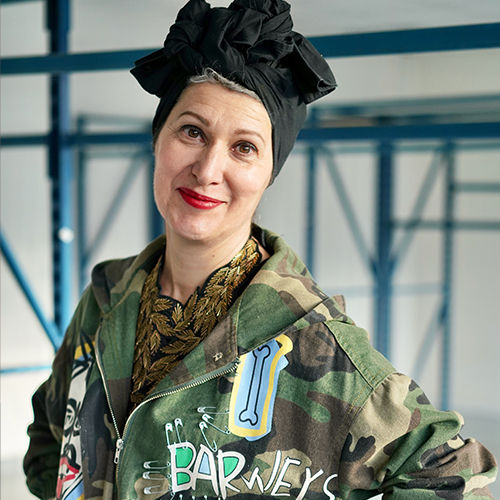
Marylin Fitoussi
Costumer Designer
Netflix Show - Emily In Paris
50% of the costumes in Emily in Paris are pre-loved
Netflix’s renowned show Emily in Paris’s costume designer Marylin Fitoussi is known for depicting stories through character’s outfits and styling. In an interview with Fibre2Fashion, the designer discusses French culture as well as current trends and style suggestions for a basic day.
Fibre2Fashion: Where are you based and how would you describe fashion in your country?
Marylin Fitoussi:
I have been based in Paris for the past five years. Earlier, I used to live in Mexico, and I adore that country. People are nice. They are people who like colour and print. It's like India, we love colours. But I would like to be in Paris for the moment. Honestly, I am enjoying it. It’s amazing. In Mexico, it’s difficult to find very nice fabrics, and it is very difficult to get clothes from Europe and is very expensive too. But you find very interesting young designers who do interesting things without good fabrics. They are really creative, and I love the way they use some very precise things from their own culture and remix them in a modern way.
F2F: How did you start your career in fashion? Was being a costume designer pre-decided?
MF:
Since childhood, I loved visualising stories and depicting a story through garments. I started my career 28 years ago doing movies. I was doing period and contemporary movies.
F2F: How did you discover about Paris and its French culture, and can you shed some light on French fashion and culture?
MF:
Paris is supposed to be the capital of fashion, which is less true. You have all the fashion world here, but normal people, for several years, are more casual. French people don’t like colours, they don’t like a lot of prints. They usually love navy blue, black and grey. When you go to fashion week, everybody is well dressed and it is one specific instance. But in general, I find this trip less and less interesting. And people are less well-dressed even when you go to the opera. Earlier, when I was younger, people used to dress for the opera, but now they wear jeans paired with a jacket. And I am very worried about that.
F2F: How did you manage to grab the opportunity to design for Emily in Paris and how was the experience?
MF:
F2F: Emily in Paris was a big break for you as a costume designer?
MF:
Yes, but every project is challenging. Emily in Paris appears to be a remarkably successful series, but I have been designing for the last 28 years. In 28 years of my career, this series has been the most popular show that I have done. So, people now imagine that I just started my career with this, but honestly, I have been doing costume designing for a very long time.
F2F: Which character do you adore the most?
MF:
I think all of them are like my children. I love them all. Everybody’s different. I had fun from Lily to Ashley. I love to design for Philippine. I feel closer to her, the character of Sylvie because we are basically the same age. So, it’s easier for me to understand the body and that we don’t want to hide it because we are becoming old and the skin and the flesh is not as good as it was. Meanwhile, with Lily, it’s always very joyful because we have a lot of fun, we have no limit and she really embraces the character. She decided that she needed to go as far as we can go. she knew from the beginning that she would be criticised that her style was very eclectic and very unique, but she was supportive and for that reason, it was really a great pleasure to work with her. She’s really focused and she’s really professional and very easy to work with.
F2F: What are your favorite looks from both the seasons of Emily in Paris?
MF:
On Emily, the drip with the big bow and the kimono that she was wearing for her birthday from season one. Also, I love when she has the total pink look—pink Louboutin shoes with pink stockings, pink skirt, with jacketing code. The pink look is what I really love. This season, I love all the Julian’s looks as I knew him before the time, so I did have time to design suits for him. So, I really like all the outfits that he is wearing this season.
F2F: As a costume designer, what things are to be kept in mind while designing costumes for a character?
MF:
First, you need to read the script. And you need to understand who the character is. So that’s why I’m not interested in brands. I don’t choose Valentino, because it’s Valentino. I chose one dress from Valentino because that dress is helping me to tell my story. That is something that people should know. When you buy something, don’t care about the brand. You have very nice pieces at H&M and Chanel but you shouldn’t buy a brand because it’s a brand. You should find the good pieces for your body, your complexion, your skin tone, your shape, what you are comfortable with which nobody else can decide for you. Fashion magazines cannot decide for you what you should wear or not to wear. It’s your body and you need to find the right proportion for your body, and that’s the most important rule.
F2F: Were there any other designers that you collaborated with for the show?
MF:
I wanted to promote many French brands and the French culture because we are in Paris, so we need to promote Paris. But I also wanted to promote Greek designers like Rianna + Nina. I also wanted to promote fashion from not so well-known Greek and Danish designers. I used many Danish designers too. And of course, I used Italian designers like Valentino and Armani. Actually, several brands wanted to collaborate with us, so we were very lucky as we had a lot of options, and it was very nice to collaborate with all of them. I could choose very nice and beautiful pieces for free.
F2F: Where do the costumes go once worn?
MF:
They go to a very secret place. For season two, we had a lot of clothes by couture houses. They sent us a lot of clothes. We pick up from them and send the remaining back. Clothes from the old crew are sent back or to very high-end couture houses. The used costumes are kept in lockers, and I do not know how many of them we have. Netflix wants to keep that way, but my secret dream will be to use them again if I do season three. I’m not sure yet about doing the third season because I am on a huge project, but I would love to re-use the iconic pieces of Emily that she was wearing in season one and to transform them into other pieces for the next season, to record the black and white suit and to make her dress something different. I also assume that the pieces would be exhibited later.
F2F: Can you shed some light on current trends and what to wear on a basic day?
MF:
People, especially the younger generation, will go more and more for vintage pieces and true recycling. Secondly, big couture houses like Valentino and Jean Paul Gaultier Couture have their own websites that would print with a larger tool for their pre-born collections. They put online some of their vintage pieces that you can buy or rent. People will be more focused and interested in upcycling in pre-owned / pre-loved.
Arun Sirdeshmukh
Anurag Batra
Aseem Prakash
Bill D’Arienzo
Pradip Mehta
Abhay Gupta
Rahul Mehta
Fanny Vermandel
Gabi Seligsohn
Rahul Mehta









_8.JPG)



